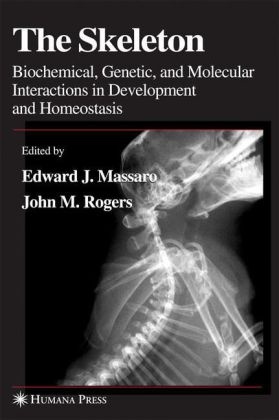Share
Fr. 189.00
Edward J Massaro, Edward J. Massaro, John M Rogers, John M. Rogers
The Skeleton
English · Hardback
Shipping usually within 6 to 7 weeks
Description
The skeleton is a complex multifunctional system. In addition to its mechanical/structural support function, it is, as the major reservoir of calcium, intimately involved in intracellular signaling pathways of critical importance both in the complex process of development and the maintenance of physiologic homeostasis. It is also, as the major source of blood cells, a critical part of the circulatory, respiratory, and immune systems. In The Skeleton: Biochemical, Genetic, and Molecular Interactions in Development and Homeostasis, established biomedical researchers, developmental biologists, and clinical practitioners offer a cutting-edge survey of diverse critical issues in bone biology. Topics range from chondrogenesis, chondrocytes, and cartilage to skeletal dysmorphology, and include the control of skeletal development, osteoblastic cell differentiation, and bone induction, growth, remodeling, and mineralization. The authors focus on the biochemical, genetic, and molecular interactions that support the development and homeostasis of the skeleton. Their state-of-the-art understanding of bone physiology-and how it is modified throughout all the stages of life-offers novel approaches for improving the endurance of load-bearing implants, achieving life-long optimal bone strength, overcoming microgravity (space flight), and hastening the healing of fractures, osteotomies, and arthrodeses. Equally important are their insights into metaphyseal fractures in the aged, into the mechanism(s) of osteopenia and osteoporosis, and into how and why, during menopause, healthy women lose only bone adjacent to the marrow.
Authoritative and up-to-date, The Skeleton: Biochemical, Genetic, and Molecular Interactions in Development and Homeostasis offers biomedical and clinical researchers rapid access to the latest understanding of the biochemistry, physiology, pharmacology, genetics, molecular biology, developmental biology, and aging of the skeleton.
List of contents
"I. Chondrogenesis, Chondrocytes, and Cartilage
Molecular Basis of Cell-Cell Interaction and Signaling in Mesenchymal Chondrogenesis
Rocky S. Tuan
Chondrocyte Cell Fate Determination in Response to Bone Morphogenetic Protein Signaling
Lillian Shum, Yuji Hatakeyama, Julius Leyton, and Kazuaki Nonaka
Regulation of Chondrocyte Differentiation
Andreia M. Ionescu, M. Hicham Drissi, and Regis J. O'Keefe
Continuous Expression of Cbfa1 in Nonhypertrophic Chondrocytes Uncovers Its Ability to Induce Hypertrophic Chondrocyte Differentiation and Partially Rescues Cbfa1-Deficient Mice
Shu Takeda, Jean-Pierre Bonnamy, Michael J. Owen, Patricia Ducy, and Gerard Karsenty
Molecular Biology and Biosynthesis of Collagens
Johanna Myllyharju
Mechanotransduction Pathways in Cartilage
Qian Chen
II. Control of Skeletal Development
Molecular Genetic Analysis of the Role of the HoxD Complex in Skeletal Development: Impact of the loxP/Cre System in Targeted Mutagenesis of the Mouse HoxD Complex
Marie Kmita, Denis Duboule, and József Zßkßny
Control of Development and Homeostasis Via Regulation of BMP, Wnt, and Hedgehog Signaling
Renee Hackenmiller, Catherine Degnin, and Jan Christian
FGF4 and Skeletal Morphogenesis
Valerie Ngo-Muller, Shaoguang Li, Scott A. Schaller, Manjong Han, Jennifer Farrington, Minoru Omi, Rosalie Anderson, and Ken Muneoka
Retinoid Signaling and Skeletal Development
Andrea D. Weston and T. Michael Underhill
Retinoids and Indian Hedgehog Orchestrate Long Bone Development
Maurizio Pacifici, Chiara Gentili, Eleanor Golden, and Eiki Koyama
III. Osteoblastic Cell Differentiation
Synergy Between Osteogenic Protein-1 and Osteotropic Factors in the Stimulation of Rat Osteoblastic Cell Differentiation
John C. Lee and Lee-Chuan C. Yeh
Bone Morphogenic Proteins,"
Summary
A cutting-edge review of the biochemical, physiological, pharmacological, genetic, and molecular interactions involved in the development and homeostasis of the skeleton. Topics range from chondrogenesis, chondrocytes, and cartilage to skeletal dysmorphology, and include the control of skeletal development, osteoblastic cell differentiation, and bone induction, growth, remodeling, and mineralization. The authors' understanding of bone physiology-and how it is modified throughout all the stages of life-offers novel approaches for improving the endurance of load-bearing implants, achieving life-long optimal bone strength, overcoming microgravity situations (space flight), and hastening the healing of fractures, osteotomies, and antrodeses.
Additional text
"...a valuable book...Every substantial biomedical library should have this book." -Doody's Health Sciences Book Review Journal
"Very detailed, clinical and laden with biological terminology, which makes the preface a must for new readers." -E-STREAMS
"Authoritative and up-to-date... a cutting-edge survey of diverse critical issues in bone biology." - Clinical Laboratory International
Product details
| Assisted by | Edward J Massaro (Editor), Edward J. Massaro (Editor), John M Rogers (Editor), John M. Rogers (Editor) |
| Publisher | Springer, Berlin |
| Languages | English |
| Product format | Hardback |
| Released | 17.04.2009 |
| EAN | 9781588292155 |
| ISBN | 978-1-58829-215-5 |
| No. of pages | 428 |
| Weight | 2 g |
| Illustrations | Illustr. |
| Subjects |
Natural sciences, medicine, IT, technology
> Medicine
> Clinical medicine
B, Skeleton, Medicine, Orthopedics, Fracture, PHYSIOLOGY, Orthopaedics, implant, Osteotomy, Morphology, tissue |
Customer reviews
No reviews have been written for this item yet. Write the first review and be helpful to other users when they decide on a purchase.
Write a review
Thumbs up or thumbs down? Write your own review.

